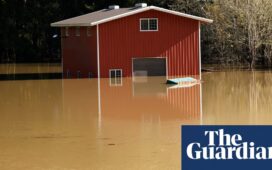Hurricane Dorian’s clear eye and near-circular symmetry, apparent in satellite images, signify a ferocious storm. The Bahamas are in serious, imminent danger. But for all we know about Dorian, which reached Category 5 on the Saffir-Simpson scale on Sunday with maximum winds of 160 miles an hour, one big question remains: Will it be a disaster for the United States?
On Friday, the computer models were in agreement on a landfall somewhere along Florida’s east coast early next week. Overnight, though, as Dorian continued its rapid intensification, the models blinked. Some of them still showed a Florida landfall, but the majority shifted their forecast tracks to the east.
On Sunday, these models showed a similar range of outcomes: landfall in Florida, Georgia or the Carolinas, or nowhere. And if Dorian does make landfall, its intensity at that point — whether it will still be a Category 5 or substantially weaker — is equally uncertain.
[Read the latest updates on Hurricane Dorian.]
So nearly the entire southeast coast of the United States, from South Florida through the Carolinas, is at risk. Yet in the end, perhaps most people in these places may well see little or no impact. The storm can take only one of the possible tracks, and some of them are harmless. That said, a buzz saw along the coast, like Hurricane Matthew in 2016, is well within the range of possibilities for Dorian, and could affect a very large area. This could be particularly bad if Dorian were to make its way up the coast slowly, prolonging the heavy rains and storm surge. These are often the most damaging hazards, though they aren’t taken into account by the numerical category, which is measured only by wind speed.
How should all the people along this long coastline deal with this confusing, uncertain forecast?
The National Hurricane Center advises that Florida residents should “have their hurricane plan in place, know if they are in a hurricane evacuation zone, and listen to advice given by local emergency officials,” and that those in Georgia and the Carolinas should “continue to monitor the progress of Dorian.” That’s all good advice, but it’s frustratingly vague and generic.
Worse, recent memories of forecast threats that didn’t materialize may cause some people to make unwise decisions. Evacuations are unpleasant and difficult, and feel even worse when the storm turns out not to be so bad at the place left behind.
In 2017, as Hurricane Irma’s forecast tracks oscillated between the east and west coasts of Florida, some people actually evacuated away from places that ended up being safe, and right into the storm’s path.
Memories like that can make people disregard warnings that they ought to heed. In 2011, Hurricane Irene’s forecasts prompted evacuations in New York, but the storm didn’t end up causing a disaster there. When Hurricane Sandy came the next year, the experiences of Irene prompted some people directly in harm’s way to stay put — to their great regret when the 2012 storm did live up to its scary billing.
Can’t meteorologists be more precise?
Not really. The scientific information forecasters are charged with communicating is uncertain not because they are doing anything wrong. The information is inherently uncertain, because of chaos, also known as the butterfly effect. Undetectable small errors in our knowledge of today’s weather quickly grow, becoming big errors in forecasts of weather a few days hence. So while we know quite a bit about Dorian’s future, that knowledge can be properly expressed only in the language of probabilities.
And because not taking a dangerous storm seriously enough can have a much bigger down side (as in people dying) than taking a not-so-dangerous storm more seriously than turns out to be necessary (people evacuate who didn’t need to), forecasters have to talk about the worst-case scenarios more than they talk about the best-case ones.
And that guarantees that there will be false alarms sometimes.
The uncertainties will not go away until the future becomes the past, but they do get smaller as that storm we’re all watching nears. So “monitor the situation” is still the right advice now, frustrating as it may be.

